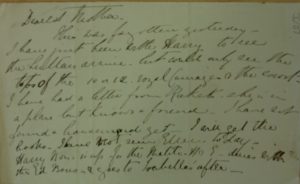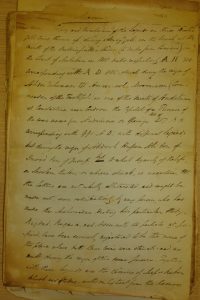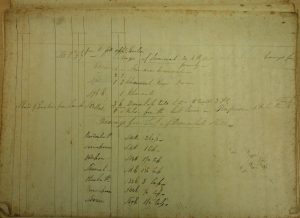The Ottoman Sultan, Ali Raja Bibi of Kannur, and Compass Bearings
The three titles in the heading do not seem to have a lot in common. Two are people but from different parts of the world, and the other is a generic term. The thing that draws them together is that I have had to research them all in the last two weeks in listing and cataloguing the Society’s collections. I continue to work on my three major projects. Both the physical and electronic records created in the production of the Journal are now sorted and ready to begin the pre-catalogue list. This I will commence next week. Further lists and catalogues will also be created for the records produced in the distribution of the Journal to subscribers and through exchanges; and for lists created regarding the Journal, copies of historic articles and ephemera. Also associated with the Journal are several prizes, but the decision was made for these to be catalogued in the section with other records for Medals, Awards and Prizes such as the Triennial Gold Medal and the Richard Burton Memorial Medal.
I have also completed an initial sort of the Charles Ambrose Storey material. I ordered some archive quality boxes to house the 38 drawers of index cards that comprise part of his archives. These have now arrived so I’m hoping to rehouse the cards in the next couple of weeks and we will then be able to remove some of the rather dubious-looking drawers that have been their home for many years. Slow but steady progress. But it is within the third major project that the Ottoman Sultan makes his appearance. You may remember that I am listing the letters of the Seymour family that are found within the Papers of Henry Creswicke Rawlinson. Louisa Seymour, one of five siblings, married Rawlinson in 1862. The family corresponded frequently and in listing the letters this week, I discovered that both Louisa and her elder brother, Henry Danby Seymour, had written to their mother to tell her that they had seen the Sultan in London. Henry quickly mentions, ‘I have just seen the Sultan come in’, at the start of his note to his mother informing her of when he will be visiting. Louisa’s letter is also just a short note but she writes, ‘I have just been with Harry to see the Sultan arrive – but could only see the tops of the 10 or 12 royal Carriages and the escort’.

Why the excitement? Abdulaziz, the 32nd Sultan of the Ottoman Empire, was the first Ottoman Sultan to visit Western Europe. Nobody had seen an Ottoman Sultan on the streets of London before! Abdulaziz wanted to create links with Europe so, in 1867, he first visited France to see the Exposition Universelle before crossing the Channel to Dover and travelling from there to London, arriving on 12 July 1867. In London, he was hosted by Queen Victoria at Buckingham Palace and she created him a Knight of the Royal Garter. During his visit the Sultan was also shown a Royal Navy Fleet Review with Ismail of Egypt. This may well have been his main purpose in visiting as he is known as the Ottoman Sultan to modernise the Ottoman Navy.
I continue to work on all these projects but, sometimes, when I’ve been concentrating on a complex project for several hours, I feel the need to take a break and turn my attention elsewhere. There are still many items that need cataloguing, so I tend to choose something that is completely different from the material with which I’d been working and which might also be potentially a ‘quick win’, in that it should be relatively more easy to sort and catalogue. As an archivist, it is always satisfying to have a researcher contact you once a catalogue is online. It’s even more satisfying when that happens within 48 hours! That is what happened with the Papers of Thomas Hervey Baber. I completed the catalogue last Friday and I was quickly contacted for copies of Baber’s documents about Ali Raja Bibi of Kannur.
Thomas Hervey Baber was born in Slingsby, Yorkshire, in 1777. His father was a solicitor. His family moved to Lincolnshire in 1780 and then to London in 1782. After early schooling Thomas went to Haileybury College and in 1796 he petitioned to join the East India Company, sailing to India in August of that year. He was first in Mumbai, where he was an assistant to the Secretary in the Public Department. He married in 1798 to Helen, a recent widow, but only 18 years old and they both moved to Calicut. Their first son was born in 1802 at Tellicherry.
Thomas, though employed by the East Indian Company, became an advocate for the abolition of slavery in Malabar area after discovering of its existence when approached to buy two children. He bought them and then cared for them in his household. He became the sub-collector for Tellicherry in 1805, and later, the English magistrate in the region. Baber, aided by his deputy, Kalpally Karunakara Menon, was instrumental in the removal from power of Pazhassi Raja in 1805.
In 1813, after witnessing a local famine, he became interested in finding alternative cash and food crops for the region, including silk production. In 1824, Thomas Baber was moved away from Tellichery and into the South Mahratta Country to Dharwar where he became Principal Collector and Political Agent. Here he found himself responsible for the running of a large prison containing several hundred Mahratta prisoners. He instituted prison reform including teaching the prisoners a trade. He created looms after asking his brother, Henry Baber, Keeper of the Printed Books at the British Museum, to send 1/5th scale models of the most efficient looms available in Britain at the time.
Baber gave several papers to the Society but only two remain as manuscripts – one concerns ‘Facsimiles of three Muhammedan Gold Coins, found on the Coast of Malabar with some remarks upon them’. The other is a copy of a translation in the Malayalam Arayam Character with an English translation undertaken by Thomas Hervey Baber, of an extract in the Malayalam Arabi character from a manuscript in the ‘possession of Ali Raja Beebee (Bibi) of Cananoor, (Kannur,) a principality on the Malabar Coast, 10 Miles North of Tellicherry’. The manuscript was believed to trace the origin of the Bibi’s family.

Ali Raja Bibi was the ruler of the Arakkal kingdom which is in current Kannur. They followed a matriarchal system of descent: the eldest member of the family, whether male or female, became its head and ruler. While male rulers were called Ali Rajah, female rulers were known as Arakkal Beevis. You can find out more about Baber and his time in India on the blog by Nick Balmer, one of Baber’s descendants.
The Thomas Baber papers were labelled when they were first accessioned into the Society’s collections. Not so, this week’s hopefully ‘quick win’. It is a bound journal containing page after page of compass bearings from somebody’s time in India. The writing is not the easiest to decipher and, sadly, whoever it belonged to, failed to put their signature on the book. I have worked through many of the donations registers but they have not provided any illumination on how the book became part of the Society’s collections. So, after cleaning and creating a suitable box for it to be housed safely yesterday, hopefully, after posting this blog post, I will catalogue it as one of our Special Collections, and maybe, some day, some researcher will shed further light upon it.

If all this writing about Collections has whetted your appetite to know more, our next Collections Evening will be on Thursday 24 March at 6.30pm, as a ‘hybrid event’. This means we will welcome attendees at Stephenson Way, and online via Zoom. If you would like to attend, whether in person or over Zoom, please register with Matty Bradley by e-mail (mb@royalasiaticsociety.org). We are looking forward to the talks by Dr Philip Jagessar who will present on ‘Mapping the RAS Map Collection’; Ian Herbertson who will present on ‘Auditing the RAS Art Collection’ and Jean-Baptiste Lamontre who will present on ‘Brian H. Hodgson, Pioneer of Himalayan Studies’. And if you are able to attend in person, there will be collections on display for you to view.
